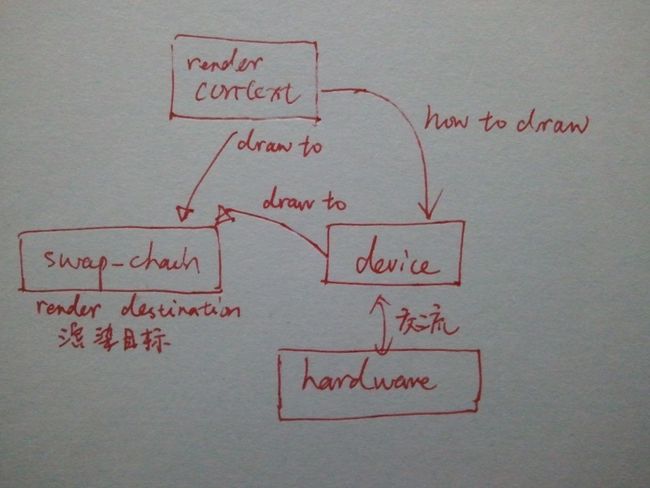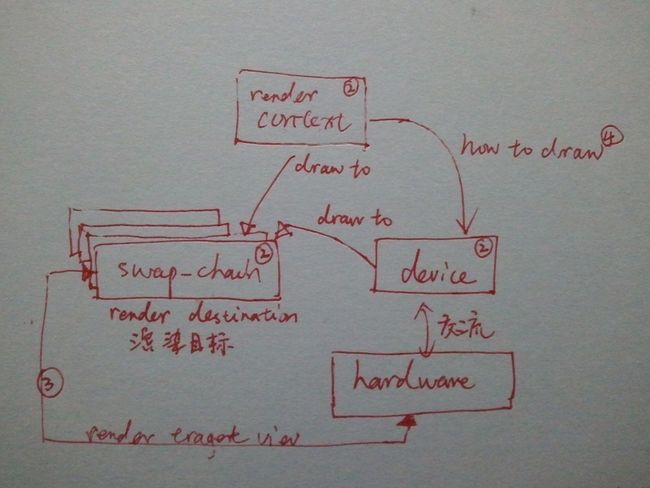上文说的 要用现实现象来模拟解释 初始化 Direct3D11的过程, 呃... 暂时想不出了, 呵呵.
一般初始化 Direct3D11的过程, 分为四步:
bool Dx11DemoBase::Initialize( HINSTANCE hInstance, HWND hwnd) { //store members
// steop 1. Description of driver types and feature level
D3D_DRIVER_TYPE driverTypes[] = { D3D_DRIVER_TYPE_HARDWARE, D3D_DRIVER_TYPE_WARP, D3D_DRIVER_TYPE_SOFTWARE }; unsigned int totalDriverTypes = ARRAYSIZE( driverTypes); D3D_FEATURE_LEVEL featureLevels[] = { D3D_FEATURE_LEVEL_11_0, D3D_FEATURE_LEVEL_10_1, D3D_FEATURE_LEVEL_10_0 }; unsigned int toalFeatureLevels = ARRAYSIZE( featureLevels);
// step 2. create swap-chain, device and context
bool result = false; result = CreateDeviceAndSwapChain( totalDriverTypes, driverTypes, toalFeatureLevels, featureLevels); assert( result == true);
// step 3. set render target view
result = SetRenderTargetView(); assert( result == true);
// step 4. set viewport
result = SetViewport(); assert( result == true);
return LoadContent(); }
开始接触Direct3D时, 觉得很烦, 需要很多的初始化对象, 还不是最终直接需要的东西, 如 step 1 中定义的一些 的结构数据; 对这种初始化创建方式的不熟悉, 应该是我自己 接触的代码量还是相当匮乏, 了解的编程编码方式不了解; 还好 前段时间在进行 linux的网络库开发时, 用到了 pthread_mtex_t 锁, 创建方式如:
//声明并定义 mutex结构体 pthread_mutex_t mutex; //声明定义 mutex使用的 属性设置 结构体 attr pthread_mutexattr_t attr; attr.xxx = yyy; attr.... = ...; //使用 属性结构体attr 初始化 mutex pthread_mutex_init( &mutex, &attr);
创建线程也有类似的方式:
//声明 线程tid pthread_t tid; //声明 线程属性 pthread_attr_t attr; //接着是 该属性的设置 pthread_attr_init(&attr); pthread_attr_setdetachstate(&attr,PTHREAD_CREATE_DETACHED); //最后使用 属性结构体 attr 创建线程: pthread_create(&tid, &attr, callback_func, NULL);
这种使用属性结构体来初始化/或创建 最终目的对象的方式 也可转换到 directx11 编程中; 如 swap-chain( 只不过这里不适用 attr类的 标记单词, 而使用 Desc后缀):
// step 2. create swap-chain(其实不仅仅是 swap-chain 啦, 还包括 device, context等, 这里是为了说明 attr/desc - creation的 编码方式)
bool Dx11DemoBase::CreateDeviceAndSwapChain( unsigned int totalDriverTypes, D3D_DRIVER_TYPE driverTypes[], unsigned int totalFeatureLevels, D3D_FEATURE_LEVEL featureLevels[]) { RECT dimensions; GetClientRect( hwnd_, &dimensions ); unsigned int width = dimensions.right - dimensions.left; unsigned int height = dimensions.bottom - dimensions.top; //第一步声明并定义 swap-chain 描述: DXGI_SWAP_CHAIN_DESC swapChainDesc; ZeroMemory( &swapChainDesc, sizeof( swapChainDesc)); swapChainDesc.BufferCount = 1; swapChainDesc.BufferDesc.Width = width; swapChainDesc.BufferDesc.Height = height; swapChainDesc.BufferDesc.Format = DXGI_FORMAT_R8G8B8A8_UNORM; swapChainDesc.BufferDesc.RefreshRate.Numerator = 60; swapChainDesc.BufferDesc.RefreshRate.Denominator = 1; swapChainDesc.BufferUsage = DXGI_USAGE_RENDER_TARGET_OUTPUT; swapChainDesc.OutputWindow = hwnd_; swapChainDesc.Windowed = true; swapChainDesc.SampleDesc.Count = 1; swapChainDesc.SampleDesc.Quality = 0; //第二步才是 创建 swap-chain, 不过 unsigned int creationFlags = 0; #ifdef _DEBUG creationFlags |= D3D11_CREATE_DEVICE_DEBUG; #endif HRESULT result; unsigned int driver = 0; for( driver = 0; driver < totalDriverTypes; ++ driver) { //匹配当前的 driver 和 feature-level result = D3D11CreateDeviceAndSwapChain( 0, driverTypes[ driver], 0, creationFlags, featureLevels, totalFeatureLevels, D3D11_SDK_VERSION, &swapChainDesc, //就是这里啦 &swapChain_, //主体讨论的对象 &d3dDevice_, //同时被创建了 &featureLevel_, //同时被创建了 &d3dContext_ //同时被创建了 ); if( SUCCEEDED( result)) { driverType_ = driverTypes[ driver]; break; } } if( FAILED( result)) { DXTRACE_MSG( "Failed to create the Direct3D device!"); return false; } return true; }
step 1. 进行 driver , feature-level 的确定; step 2. 产生 device, context 和 swap-chain . 这三者的关系( 通过书本的解释)如下图:
Direct3D device : 与硬件设备通信
Direct3D context : 告诉 Direct3D device 如何进行 draw
swap-chain : Direct3D device 和 Direct3D context 绘制的 目的地
step 3. Set render target view
其实 第3步 还是没有超出上图的 描述, 这一步主要是针对 swap-chain 和 device 的设置( 按照我刚开始学习directx11 而言), 因为 swap-chain分为 多层, 需要设置一层为 候补层 backBufferTarget, 而 其中一层 用来实际直接渲染 , that are the primary and secondary rendering buffers of a swapchain. 如下图:
// step 4. set viewport
最后的 step 4. 也没有超出上述范围, 不下图所示的 ④ 标记, 用以设置 "how to draw", 主要是坐标 /大小:
整个新的 Dx11DemoBase 基类为:
#ifndef _DEMO_BASE_H_ #define _DEMO_BASE_H_ #include#include #include class Dx11DemoBase{ public: Dx11DemoBase(); virtual ~Dx11DemoBase(); bool Initialize( HINSTANCE hInstance, HWND hwnd); void Shutdown(); virtual bool LoadContent(); virtual void UnloadContent(); protected: HINSTANCE hInstance_; HWND hwnd_; D3D_DRIVER_TYPE driverType_; D3D_FEATURE_LEVEL featureLevel_; ID3D11Device *d3dDevice_; ID3D11DeviceContext *d3dContext_; IDXGISwapChain *swapChain_; ID3D11RenderTargetView *backBufferTarget_; unsigned int width_ ; unsigned int height_ ; private: bool CreateDeviceAndSwapChain( unsigned int totalDriverTypes, D3D_DRIVER_TYPE driverTypes[], unsigned int totalFeatureLevels, D3D_FEATURE_LEVEL featureLevels[]); bool SetRenderTargetView(); bool SetViewport(); }; #endif
最新文件: Dx11DemoBase.tar
这篇写到这里, 发现跟原文叙述的过程也差不多, 但通过自己的一层层刨释, 即使是仅仅 抄写代码, 但考虑到 本随笔还是可能会被其他 观客 看到, 不能马虎, 不能行文前后矛盾, 一深入思考, 反而提升了自己对 DirectX11 的认识.


